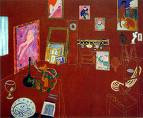
Coming across some Patrick Heron prints in the foyer of Bedruthen Steps Hotel in Cornwall on a sunny January day.
I came across some of those classic 70’s prints at the Bredruthen Steps Hotel between Watergate Bay and Newquay on the North Coast. They were just inside the foyer, shaded from the bright white light of the January morning coming in from the beach with the tide.
The simplicity of these works is what we remember Heron for. They retain an intensity that suggest the colours, usually Cadmium Red, Vermillion and Dioxide Purple, actually vibrate next to each other in their organic lozenge shapes, tethered to their space, playing their part of the composition-oscillating colour!
This pair of modest sized prints had so much power compared to those of the landscape paintings of the coasts of Cornwall on the walls around them by other artists, in this lovely louche yet chic hotel. That these two prints should reflect so subtly the rocks, coves and pools that Cornwall is known and for it to be expressed so deftly in an abstract language by a master of British abstraction most probably unknown to many visitors who pass the prints on the way from the bar to the toilet and back to the bar again as we did. A distraction from the conversation, company, they retain your gaze, steady your balance as all good art should, they seem so aptly placed.
I have a soft spot for Patrick Heron and his paintings. There are few abstract painters in Britain of the last 50 years that achieved as much as he has as a painter, a critic, writer and educator. In post-war Britain, especially London, when Tate had a ‘the’ in front and wasn’t particularly Modern, there was little serious interest in abstraction, let alone in the work of the ‘fiddling rustics’ down in Cornwall known as the ‘St.Ives School’.
He saw his generation of painters and especially himself, as following historically the modernist 'tradition' in painting after Braque, Bonnard, Cezanne and Matisse.
And so these subtle luminous prints go on oscillating, between the bar and the toilet, regardless of the temporary inhabitants knowledge of this truly British modern master.
(These two prints are from 1970 and are not from the Bedruthen Steps Hotel (they are however from the same print run and are courtesy of the Adam Gallery, Bath.)




